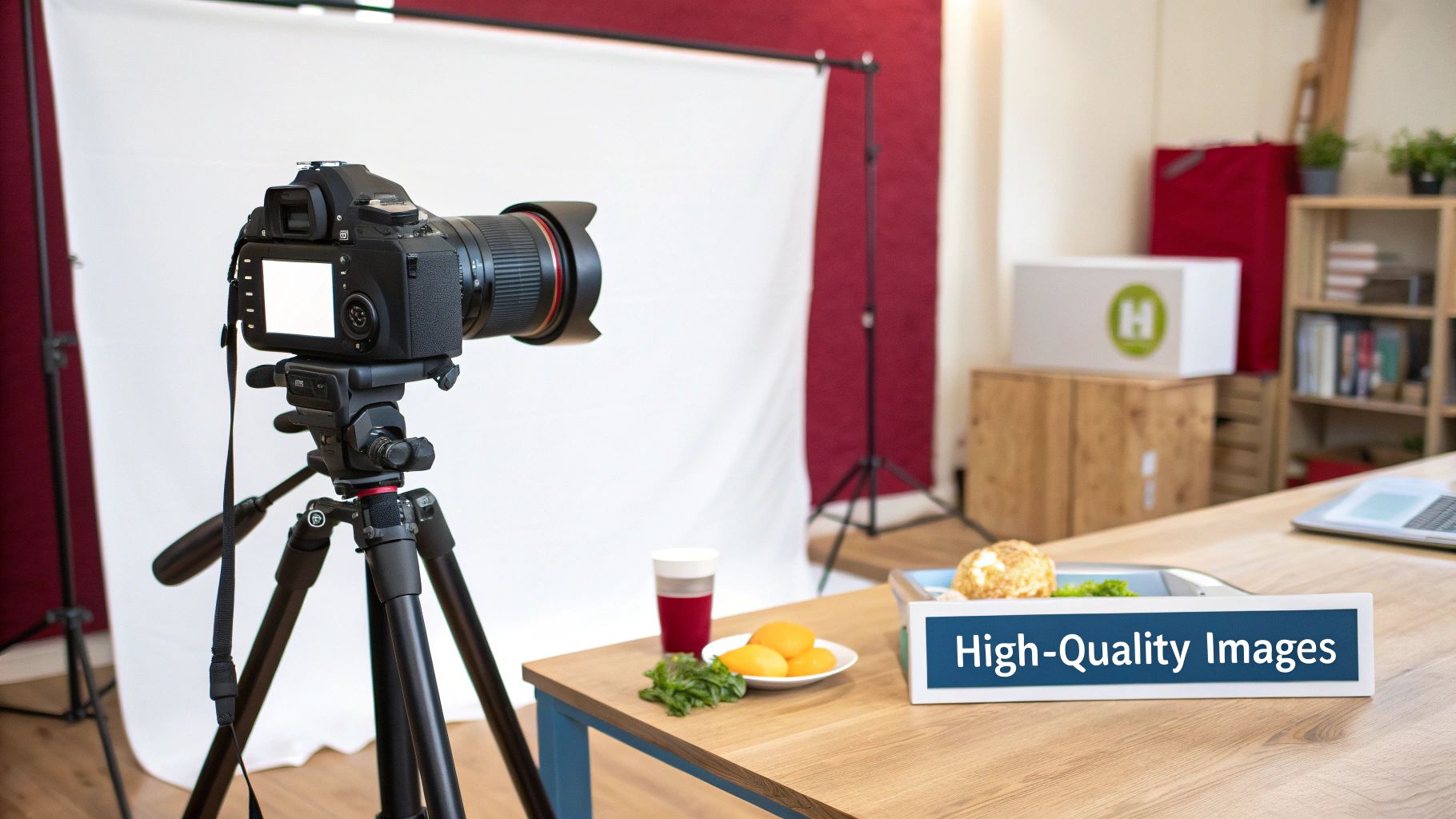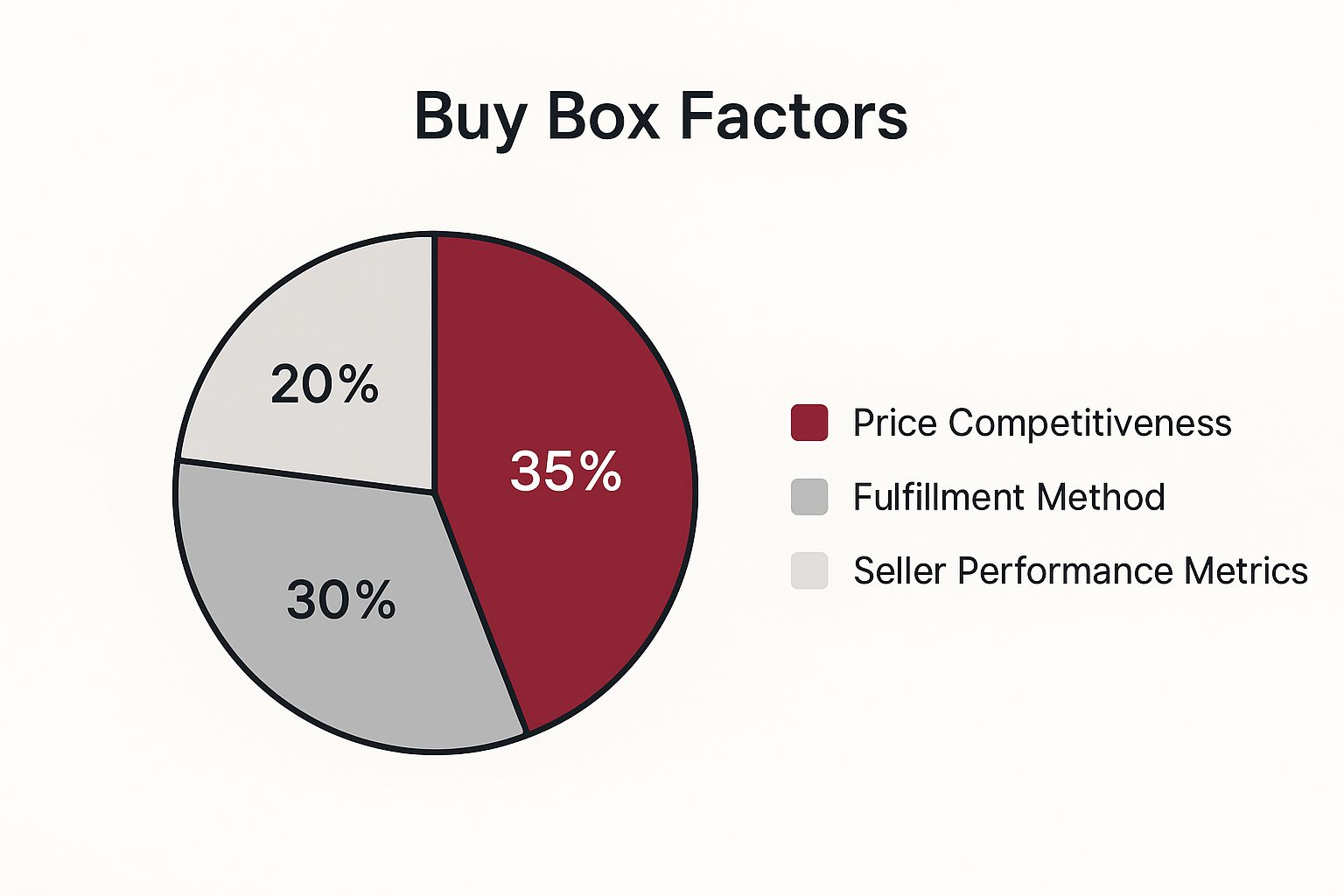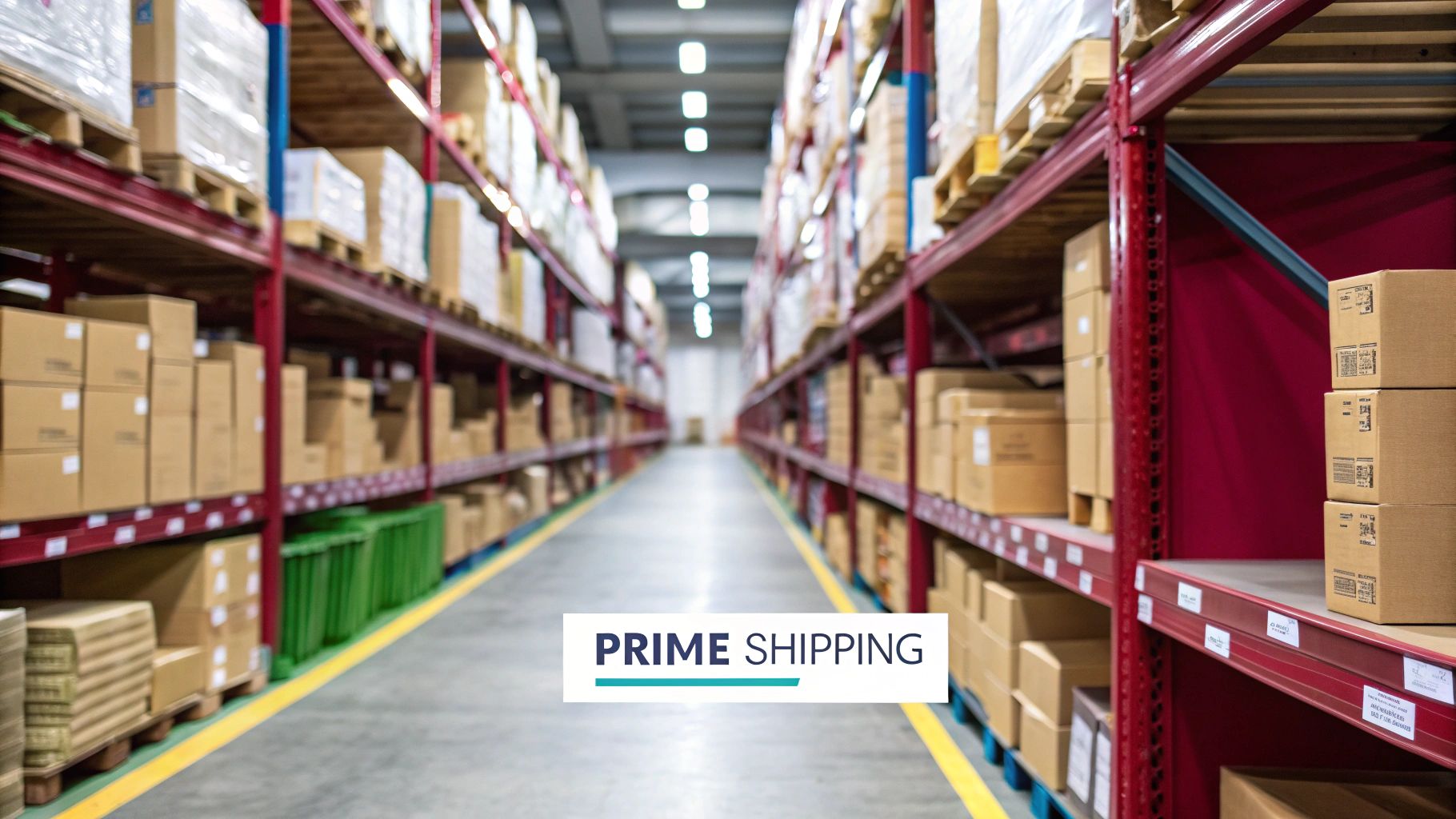Selling on Amazon is a repeatable game plan. Succeeding on Amazon in 2025 requires a solid strategy covering everything from picking a winning item to keeping it in stock without paying crazy storage fees. Many sellers get stuck with low sales, high ad spend, and inventory problems because they miss the small details that actually drive sales.
This guide cuts the fluff. We’ll walk through the practical actions that separate the top 1% of sellers from everyone else. Let’s get into what’s working right now.
1. Pick Products That Actually Sell
Finding a product is easy. Finding a product that sells is the real challenge. Your success starts here, and guessing is not a strategy. You need data to back up your decisions.
- Find Product Demand: Use a tool like Helium10 Black Box to spot high-demand, low-competition niches. Look for products with consistent sales but where the top sellers have clear weaknesses, like poor images or a low review count.
- Validate Demand: Don’t just trust one tool. Cross-reference what you find with Helium10 Trendster and Google Trends to see if interest is growing, stable, or declining. Is it a seasonal fad or an evergreen product?
- Analyze the Competition: Use the Helium10 Listing Analyzer to dig into your potential competitors. Look for gaps in their pricing, negative review patterns you can solve, and overall listing quality.
- Avoid Oversized Items: For your first few products, stick to standard-size items. Oversized products come with much higher FBA fees that can destroy your profit margins if you’re not careful. Check the FBA fee thresholds before you commit.
2. Go Deep on Keyword & Market Research
Keywords are the language of Amazon. If you don’t know what words customers are typing into the search bar, you’re invisible. This isn’t a one-time task; it’s an ongoing process of discovery and optimization.
- Find Ranking Keywords: Use Helium10 Cerebro to see exactly what keywords your top competitors are ranking for. This is like getting their playbook for free.
- Add Long-Tail Keywords: Don’t just go after the big, high-volume keywords. Target longer, more specific phrases (long-tail keywords) that have lower competition and often convert better. For example, instead of “yoga mat,” target “non-slip yoga mat for hot yoga.”
- Use Amazon Brand Analytics: If you’re Brand Registered, Amazon gives you a goldmine of data. Check the Top Search Terms & Search Query Performance reports to see what terms customers are using to find your products and where you can improve your rank.
- Track Keyword Performance: It’s not enough to find keywords; you need to know if your efforts are working. Use Helium10 Keyword Tracker to monitor your organic rank for your most important terms.
3. Build a Listing That Converts
Your listing is your 24/7 salesperson. Its job is to grab attention and persuade a shopper to click “Add to Cart.” Every section needs to be optimized to work together.

- Title: Follow this formula: Brand Name + Main Keyword + Key Benefit + Other Details. Keep it under 200 characters. For example: “Brand XYZ Non-Stick Silicone Baking Mat for Easy Cleanup.”
- Bullet Points: Use all five bullet points. Aim for two relevant keywords per bullet and mix emotional benefits (e.g., “Spend less time cleaning”) with technical features (e.g., “Dishwasher safe”).
- Description: Tell a story about the product and expand on the features mentioned in the bullet points.
- Backend Keywords: These are hidden keywords that customers don’t see. Use Helium10 Scribbles to find relevant keywords you haven’t used in your title or bullets and add them here.
- A+ Content: If you’re Brand Registered, use A+ Content. Add lifestyle images, comparison charts, and brand stories to build trust and increase conversion rates.
4. Images & Visual Strategy
People buy with their eyes. On Amazon, your images are your product. Bad photos will kill sales, no matter how good your product is.

- Main Image: This is your most important photo. It must have a pure white background and show the product clearly. A/B test different main images to see which one gets the highest click-through rate (CTR). A good main image can be responsible for up to 20% of your ranking power.
- Lifestyle Images: Show your product being used in a real-life setting. This helps customers visualize themselves using it.
- Infographics: Create images that highlight key features, dimensions, or benefits. This is a great way to answer common questions before they’re asked.
- Image Order: Structure your images logically. A good flow is: Main Image -> Lifestyle -> Infographic -> Comparison Chart -> How-to/Benefit Shot -> Packaging -> Video.
- Use All Image Slots: Aim for 7-9 high-resolution images (at least 1000×1000 pixels) to enable the zoom feature.
5. Get Smart with Pricing, Offers & Bundles
Pricing isn’t just a number; it’s a signal of value. You need to be competitive without starting a race to the bottom that destroys your profits.

- Competitive Pricing: Use Helium10 Listing Analyzer to see what your competitors are charging. Don’t just copy them; find a price point that makes sense for your brand and profit goals.
- Create Bundles: Combine your main product with a smaller, complementary accessory. This increases the average order value (AOV) and can make your offer more appealing than a competitor’s.
- Use Coupons: Running a 5-10% coupon is a great way to make your listing stand out in search results and lift your CTR.
- Lightning Deals: Before big events like Prime Day or Black Friday, check the “Price Discounts” section in Seller Central. If Amazon recommends your product for a Lightning Deal, it’s often a good way to get a quick sales boost.
Explore more advanced Amazon pricing strategies on ecombrainly.com to find what works for your products.
6. Choose the Right Fulfillment & Shipping Strategy
How you get your product to the customer is just as important as the product itself. For most sellers, Fulfillment by Amazon (FBA) is the best choice.

- Choose FBA: Using FBA makes your products eligible for Prime shipping, which is a huge conversion driver. Use the Amazon FBA Revenue Calculator to check your profitability before you commit.
- Check Delivery Times: If you fulfill orders yourself (FBM), your delivery time needs to be under 3 days to have a good chance at winning the Buy Box.
- Monitor FBA Fees: Keep an eye on your FBA fees, especially long-term storage surcharges. These fees can add up quickly and eat into your profits.
You can learn more about if Amazon FBA is worth it on ecombrainly.com.
7. Control Your Inventory & Restocking
Going out of stock is one of the worst things that can happen to your listing. Your sales rank plummets, and it’s expensive and time-consuming to get it back.
- Track Stock Levels: Set up Restock Alerts in Seller Central so you know when it’s time to reorder.
- Forecast Demand: Don’t guess how much to order. Base your forecast on your sales from the last 30-60 days, plus any upcoming seasonal spikes.
- Avoid Long-Term Storage Fees: Amazon charges extra for inventory that sits for more than 365 days. Plan to remove any slow-moving products before you get hit with these fees.
- Automate It: As you grow, use a tool like SoStocked or Helium10 Inventory Protector to automate your inventory planning.
8. Build Trust with Reviews & Ratings
Reviews are the social proof that drives sales. No one wants to be the first person to buy a product. A solid review strategy is non-negotiable.
- Use Amazon Vine: For new products, enroll in the Amazon Vine program. You can get up to 30 high-quality reviews from trusted reviewers, which is a great way to get initial momentum.
- Send Review Requests: A few days after a product is delivered, use the “Request a Review” button in Seller Central. You can also use automated software like CaptainAMZ to handle this for you.
- Handle Negative Reviews: When you get a negative review, respond publicly and politely. Offer a solution if possible. This shows other customers that you care about their experience.
Learn more about how to get reviews on Amazon for additional compliant strategies.
9. Run Smart Advertising & Promotions
Amazon Pay-Per-Click (PPC) is how you get your product in front of shoppers, especially when you’re new. Think of it as paying for visibility.
- Launch PPC Campaigns: A good starting structure is to run an automatic campaign to discover what customers are searching for. Then, move the successful keywords into manual campaigns (Broad, Phrase, and Exact match) where you have more control.
- Track Keywords: Use a tool like Helium10 Adtomic to monitor your daily PPC performance. You need to know which keywords are making you money and which are wasting it.
- Adjust Your Bids: Don’t set your bids and forget them. Lower the bids on keywords with a low CTR and raise them on keywords that are converting well.
- Mix Your Promos: For a product launch or a big sales push, combine deals, coupons, and ads to create a powerful effect that boosts your ranking.
If you need support, you can explore professional Amazon ads management services to handle this complexity for you.
10. Sync Your Rank & PPC Efforts
Your organic rank and your PPC campaigns are connected. A smart PPC strategy can help improve your organic rank over time.
- PPC Helps Organic: Focus your ad spend on keywords where your product is already ranking on the bottom of page one or the top of page two (positions 15-30). A few extra sales from ads can push you onto the first page organically.
- Lower Your ACoS: Every week, review your campaigns and pause keywords that aren’t performing well. This is the fastest way to lower your Advertising Cost of Sale (ACoS).
- Optimize Your Listings: Make sure the keywords you’re targeting in PPC are also in your listing’s title and bullet points. This improves your ad’s relevance and can lead to a higher CTR.
11. Test & Optimize Everything
The best sellers are constantly testing. Never assume your listing is perfect. There’s always room for improvement.
- A/B Testing: Use the “Manage Your Experiments” tool in Seller Central to A/B test your titles, main images, and A+ Content.
- Monitor CTR: If your click-through rate is below 0.3%, it’s a sign that your main image or title isn’t grabbing attention. It’s time to test a new one.
- Track Conversion Rate: If your conversion rate is below 10%, it means people are clicking on your listing but not buying. This could be a problem with your price, images, or bullet points.
- Change One Thing at a Time: When you run a test, only change one element. Wait 7-10 days to see the impact before you make another change.
12. Keep an Eye on Competitors & the Market
Your competitors are not standing still, and neither should you. You need to know what they’re doing so you can react quickly.
- Track 3-5 Main Rivals: Use a tool like Helium10 Market Tracker to monitor your main competitors’ sales, pricing, and reviews every week.
- Watch for Changes: Did a competitor change their main image? Did they drop their price? Did their reviews suddenly jump? These are all signals you need to pay attention to.
- Adapt Fast: If you see a competitor making a move that works, learn from it and adapt your own strategy.
13. Scale & Expand Your Business
Once you have a profitable product, it’s time to think about growth. Don’t just rely on one ASIN.
- Launch Related Products: Create variations (different colors or sizes) or bundle your product with complementary items. This is the easiest way to expand your catalog.
- Enter New Marketplaces: If you’re successful in the US, consider expanding to Canada, the UK, or Mexico.
- Automate: Use tools like Adtomic for PPC and SoStocked for inventory to automate the daily tasks so you can focus on growth.
- Consider an Agency: Once you reach a certain size, hiring an Amazon agency can help you scale faster than you could on your own.
14. Improve Your Average Order Value (AOV)
Getting a customer to your listing is hard work. Once they’re there, you want to encourage them to spend as much as possible.
- Use Subscribe & Save: If you sell a consumable product, offering a Subscribe & Save discount is a great way to get recurring revenue.
- Cross-Link Products: In your A+ Content and Brand Story, feature your other products. Use comparison charts to show how your different items solve different problems.
- Create Virtual Bundles: If you’re Brand Registered, you can create “virtual bundles” that allow customers to buy two or more of your products together, often at a slight discount.
15. Drive External Traffic to Your Listing
Don’t rely solely on Amazon for your traffic. Driving your own external traffic can give you a big advantage.
- Use Social Media: Create short-form videos like Instagram Reels or TikToks showing your product in action. Put a link to your Amazon listing in your bio.
- Work with Influencers: Send your product to small influencers in your niche and ask them to create user-generated content.
- Run Google Ads to Amazon: Use Amazon Attribution to track the performance of your Google Ads. This lets you see exactly how many sales your off-Amazon ads are driving.
- Build a Brand Website: Create a simple website to collect email addresses and tell your brand story. You can then direct that traffic to your Amazon listings.
Your Next Steps to Amazon Growth
You’ve just walked through the key strategies that separate stagnant Amazon listings from successful brands. From product research to PPC, these tips for selling on Amazon are the daily actions that top sellers take. The journey doesn’t end here; it’s a continuous cycle of doing, testing, and improving.
Don’t try to do everything at once. That’s a recipe for burnout. Instead, pick one high-impact area and commit to improving it this week.
Here’s how to turn this into action right now:
- Audit Your Top Product: Look at your best-selling ASIN. Is your main image really stopping the scroll? Are your bullet points talking about benefits or just listing features?
- Check Your PPC Data: Open your ad console and find the top three most expensive keywords that haven’t made a sale in the last 30 days. Add them as negative keywords. This simple action can immediately improve your profitability.
- Look at Your Inventory Health: Log into Seller Central. What’s your Inventory Performance Index (IPI) score? Do you have any products getting close to long-term storage fee deadlines?
Success on Amazon isn’t about finding a secret hack. It’s about building a solid system based on data and a deep understanding of your customer. The best sellers are always optimizing. Keep learning, keep testing, and most importantly, keep taking action.





